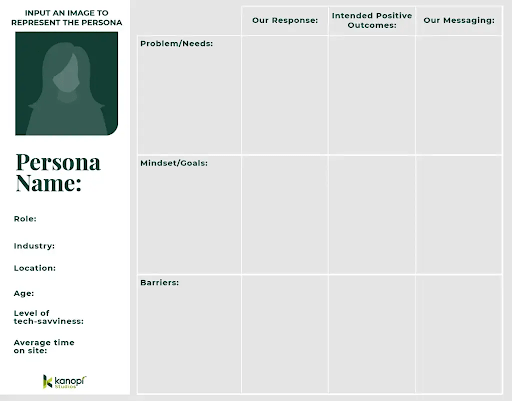
Blogs are a powerful tool for nonprofits. They offer a unique opportunity for nonprofits to share stories, drive engagement, and connect with their audience meaningfully. However, an effective nonprofit blog requires a strategic approach that goes beyond simply publishing content, so make sure you add it to your communications strategy and plan accordingly.
At C(, we are committed to providing nonprofits with the tools required to excel in the digital world. Similarly, we recognize the valuable insights and tips from fellow nonprofit bloggers who share their expertise and experiences, so we had to share these… The following are ten actionable nonprofit blogging best practices, sourced directly from Nonprofit Hub, that will help you master nonprofit blogging!
1. Align content to your target audience’s interests.
One of the most important steps in building a productive blogging strategy is creating content that engages and appeals to your audience. Supporters won’t read your blog just because they have a relationship with your nonprofit—they want to engage with informative, interesting content that actively furthers their understanding of your cause.
To understand your audience’s interests, create audience personas. These are fictional representations of different audience segments. For instance, you could create personas based on how individuals interact with your mission, whether as volunteers, donors, or beneficiaries.
Add specific details that bring your personas to life. For example, you can answer these questions:
- What communication platforms do these individuals use?
- What other blogs do they like to read?
- Who do they follow on social media?
Then, strategize ways to match your language, tone, and style to your audience’s interests. For example, let’s say you create a persona for your younger supporters. You could create blog posts that incorporate social media posts and TikTok videos to appeal to younger audiences’ interests.
Use this template to facilitate the persona creation process:

This template offers space to add demographic and behavioral information about your personas and strategize your intended messaging. Build around three to five primary personas to ensure that you’re reaching everyone in your target audience.
2. Vary your post length.
Make your blog roll more dynamic by mixing up your blog post lengths. There are advantages to writing both short and long-form posts:
- Short-form posts of around 300-500 words can be read quickly from a mobile device and they help deliver timely or urgent messages to your audience. For example, you could publish a short post to update your audience on how far you are from your $20,000 crowdfunding campaign goal.
- Longer, in-depth posts of 1,500 or more words allow you to dive more deeply into important topics that your audience is interested in. Longer posts that provide comprehensive, credible information about a specific topic also help improve your blog’s search engine rankings. You could write longer posts to share a beneficiary’s story or explain a complex issue relevant to your mission.
Since longer-form posts take more time to craft, plan to publish them less frequently, such as once a month. That will give you the time you need to make these posts comprehensive and incorporate engaging multimedia elements.
3. Create engaging and interactive content.
Research shows that interactive content earns more engagement and twice as many conversions as static content. Consider incorporating interactive content into your blog, such as:
- Quizzes
- Polls
- Image galleries or slideshows
- Interactive maps
- Interactive videos
Your nonprofit’s content management system (CMS) may offer built-in tools or add-ons that make it easier to create interactive content. For example, WordPress offers plenty of free and premium plugins for extending your blog’s functionality. For more complex content needs, it’s recommended to work with a professional developer or designer to bring your ideas to life.
4. Make your content inclusive and accessible.
Inclusive and accessible content makes your blog readable and relatable to all visitors, no matter who they are. Build an inclusive online community by adding these elements to your blog posts:
- Images with diverse individuals that reflect the demographics represented by your nonprofit’s supporters and beneficiaries. Add authenticity by using unposed images of real community members rather than stock photos.
- Options to read your content in different languages depending on your audience’s needs. For example, you could make your content available in both Spanish and English if many members of your community speak both languages.
- Accessible content, with alternative text for images, captions for videos and audio elements, sufficient color contrast, and other usability must-haves.
- Simple language free of jargon. Casual content makes your blog more welcoming to new audiences.
Inclusive and accessible content provides a better online experience for all website users and shows supporters that your organization values their individual needs.
5. Ensure your content is useful and relevant.
Build your nonprofit’s authority, credibility, and trustworthiness by offering truly educational and useful blog content. Take steps such as:
- Adding statistics and hard data relevant to your nonprofit’s work or cause area
- Highlighting past successes using data, first-hand interviews, and images
- Posting news, updates, and press releases related to your cause
You can also share helpful information, resources, and how-to guides relevant to your organization’s mission. For example, if your nonprofit is focused on promoting fire safety, you can offer a how-to guide for keeping your home fire-safe in dry months, citing instructions and best practices from the National Fire Protection Association.
With educational content like this, supporters will consider your blog a valuable resource and check it more regularly to stay informed.
6. Tell compelling stories.
If you want to truly connect to your audience through your blog posts, they need to evoke powerful emotions. Facilitate a stronger relationship by sharing compelling personal stories related to your nonprofit.
For example, share a story of how a family with a shy 6-year-old daughter adopted a dog from your animal shelter, and describe how the dog helped her come out of her shell and thrive.
Create emotional ties to your content by including images, audio clips, and videos that bring your stories to life. Images in particular are much more attention-grabbing than text alone—they’re much more likely to be remembered, and the human brain can process them incredibly quickly (in only about 13 milliseconds).
7. Spotlight your supporters.
Your supporters make it possible for your nonprofit to work toward your mission, meaning they should be centered in your blog content. Use your blog to spotlight supporters’ accomplishments and stories. Interview audience members such as:
- Volunteers
- Donors
- Staff
- Board members
Highlight individuals from all stages of the supporter journey. For example, you could interview a long-time board member about their experience, or spotlight brand-new volunteers to welcome them to your organization. This shows audience members that you value all supporters, no matter how long they’ve been involved or how much time they can devote to your cause.
8. Maintain a consistent posting schedule.
Your blogging strategy should have a rhythm. Whether it’s weekly or three times a month, your readers should be able to rely on new and relevant content regularly. Plus, fresh content tends to perform better in search engine rankings. It also reassures your readers that your organization is active and constantly working toward its mission.
Think about it—how would you feel about a nonprofit if you visited their website and noticed they haven’t updated their blog since 2020? You may get the impression that the organization is no longer operating or that they’ve scaled their efforts down, even if that’s not truly the case. This underscores the importance of maintaining an active posting schedule.
9. Use eye-catching calls to action.
Calls-to-action (CTAs) are rallying cries you use to inspire blog readers to take action after engaging with your posts. Common calls to action include:
- Donate now
- Become a monthly donor
- Join our volunteer crew
- Share this post on social media
- Sign our petition
- Leave a comment to let us know what you think
Your blog posts inspire readers and encourage them to engage with what your nonprofit has to offer. Your CTAs give readers the tools they need to get involved.
Make it easy for readers to take the next steps by ensuring your CTAs lead to useful landing pages. For example, your “Donate Now!” CTA should lead to your mobile-friendly, streamlined, branded donation page. This builds trust with your readers and makes it convenient for them to get involved with activities they’re interested in.
10. Share your posts across all marketing channels.
Be proactive about marketing your blog posts to your audience. Many supporters may not check your website regularly, so bring your blog posts to them using promotional channels like:
- Social media. Share your posts on platforms like Facebook, LinkedIn, and Instagram. Foster engagement by responding to comments and asking supporters to share the post with their networks.
- Google Ads. Google Ads are the paid advertisements that appear at the top of Google search results. Use these ads to promote your blog posts to an audience of individuals who are searching for terms related to your nonprofit. As a nonprofit, you may also be eligible for the Google Ad Grant, which provides organizations with a free $10,000 per month in Google Ad spend.
- Email. Send out an email update when you have new blog content to share. Include a quick snippet of the post in the email and provide a link where subscribers can read the full post.
Track engagement across marketing channels to determine which platforms lead to the highest click-through rate. Focus more of your attention on your top-performing platforms to drive a higher ROI for your blogging strategy.

